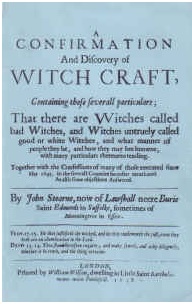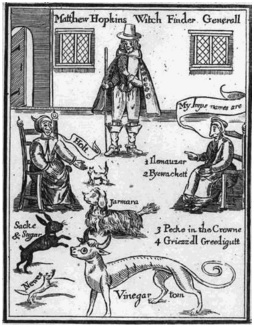The Witches of Lavenham
Elizabeth Scrope

Elizabeth Scrope, Countess of Oxford, second wife of John de Vere, 13th earl of Oxford, whom lived for much of her life in Wivenhoe and in Lavenham was vivacious, beautiful, an adventuress, tremendously loyal to the Lancastrian cause and was tried then held under house arrest for witchcraft in 1473.
Her crime was to mastermind “a ruse of war” whereby she and seven knights (including both of her future husbands) disguised themselves as pilgrims and nuns from the local Priory of Sion (of which Elizabeth was patroness) and took the castle and island of St Michaels Mount.
Embarrassingly they then held it against Edward IV’s entire west of England army for six months (eight against over 6000). Her reward was to be tried as a witch for disguising herself allegedly as a man (she observed reasonably at her trial that it was her companions disguising themselves as woman, not the other way around) however she admitted to carrying weapons into the Mount and that was enough. She stayed under house arrest from 1473 to 1485 by which time she was 28.
She died at 80, much loved at the Courts of Henry VII, Henry VIII, Edward VI and Mary I (and had lived also through the reigns of Henry VI, Edward IV, Edward V, Richard III and Jane I). She is buried in Wivenhoe alongside her first husband William Beaumont. When her Book of Hours was uncovered a few years ago it included long lists of spells she used against gout, rheumatoid arthritis, gaol fever (typhus) and also the war wounds suffered by both of her husbands. It is very revealing in showing how the boundaries between witchcraft and religion were very fudged at this time
Anne Randall, the only witch in Lavenham to be tried and executed
The following is an extract from A Confirmation and Discovery of Witchcraft by John Stearne 1648

“Also ANNE RANDALL of Lavenham in Suffolk, after she had confessed the Covenant, for still you must remember, that this is first done, before the devil, or their Familiars, or Imps, act, or do anything, confessed that she had two Imps, which were heavy and soft, but came in the likeness of Cats, or Kittens, of a blue colour, called Hangman and Jacob, and that those sucked on the marks found upon her body, some thirty years together: sometimes once a week, sometimes once a fortnight.
And that she sent her Imp Hangman to kill a horse of one WILLIAM BALDWINS of Thorpe, some two miles from Lavenham, for what she asked him to bring her in some wood, and he bade her pay for that she had had first; and the Imp returned, and told her he had done, he had killed two, for they were languished together, so he killed them both, which horses were killed (but in such a temper) as was supposed by a Devil in Thunder, until she confessed it of herself.
Also she confessed, that being at STEPHEN HUMFRIES in Thorpe aforesaid, and begging for Alms, he came home well, and she being at the door, he chided her, or gave her such words as she liked not of. As she went over the way from the house, her Imp Hangman appeared to her, and asked her what he should do, and she bade him go and kill one of his Hogs, which she saw, which she said he did before she was out of sight, which Hog died accordingly.
Likewise she further confessed, that she being angry with one MR COPPINGER of Lavenham , she sent her Imp Jacob to carry away bushes, which he had caused to be laid to fence his fences, above one load, here some, and there some, all along the hedge side, as they were to be hedged out, and in one night they were gone, no man knew what way, until such time as she confessed her Imp did it. But as I have since heard, they were known to be in another man’s ground, who confessed, they came the same night, but how, he knew not till then.”
Attempts made to replant the hedgerow on the same spot for three hundred and fifty years since her execution still see the bushes fail to grow despite repeated attempts to plant them over several years.
Hangman and Jacob remain popular names for cats in the village of Lavenham today.
The Time of the Witch Trials. The Witchfinder General: Matthew Hopkins
The Suffolk/Essex borders became the location of one of the most terrifying periods of history for the persecution of women. In a period of just three years, 60% of all witches to be executed in the recorded history of the United Kingdom were brought to trial after torture then executed at the instigation of one man.
Matthew Hopkins (c. 1620 – 12 August 1647) was an English self appointed witch-hunter during the English Civil War of 1642 to 1651. He claimed to hold the office of ‘Witchfinder General’, although this title was never official. He operated mainly in East Anglia and was solely responsible for nearly two thirds of all of the witches to be executed in England from 1400 to 1800 in just a three year period (1644-1647). He died of tuberculosis, ending his reign of terror, at the age of 26 or 27.
He is believed to have been responsible for the deaths of 300 women between the years 1644 and 1646 with the assistance of his colleague John Stearne and a number of female assistants who would prick their victims (called “prickers”) or deprive them of sleep to obtain confessions that they had signed a pact with the Devil (without this confession of a compact or contract with the Devil there could be no conviction).

Both Hopkins and Stearne wrote chilling accounts of their methods of investigation and findings. Initially, Hopkins was Stearne’s assistant in preparing for the trial of witches found in the Manningtree area of Essex and most of Suffolk in 1645. This included Anne Randall from Lavenham, against whom accusations were brought by a number of residents from Thorpe Morieux and Lavenham. Anne is the only resident of Lavenham to be found guilty and executed for being a witch. The accusations appear to be spiteful and poor Anne the victim of having been made a scapegoat for the death of two horses and a pig and the theft of hedgerows (another man would later confess to the missing bushes being in his garden but not knowing how they got there)!
Hopkins’ methods of investigation would be used at Salem during their infamous witch trial in 1692-93. They would amount to torture in this day and age and even Stearne expressed concern in the case of Elizabeth Clarke of Manningtree and how her evidence had been arrived at (A confirmation and discovery of witchcraft, 1648). The admissions were often fantastical with reference to Imps and familiars with magical powers. Some confessions were clearly made to save the lives of those being held captive by Hopkins, such as the confession of Rebecca West.
The events of 1645-1647 are not only recorded chillingly in Hopkins and Stearne’s own words The Discovery of Witches, 1647 and A confirmation and discovery of witchcraft, 1648 but Vincent Price would go on to immortalise Hopkins as one of history’s most terrible anti-heroes in the film The Witchfinder General, much of which is set in Lavenham, Bury St Edmunds and Orford.
